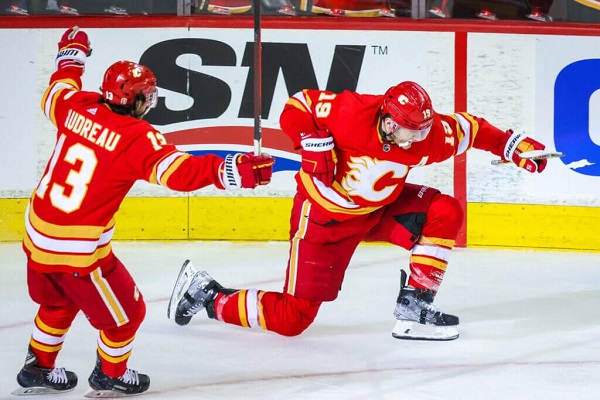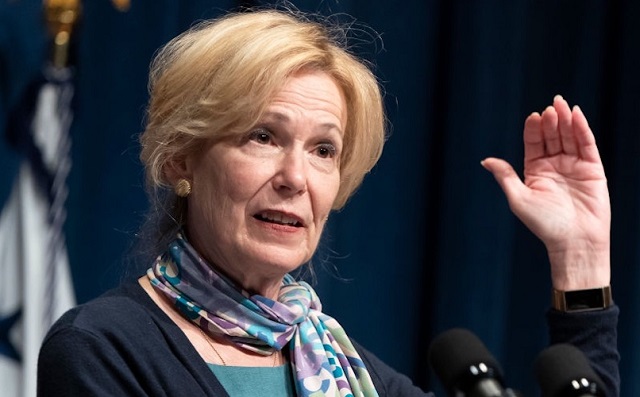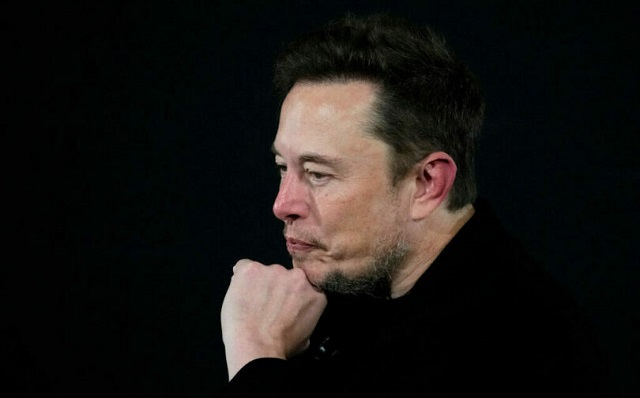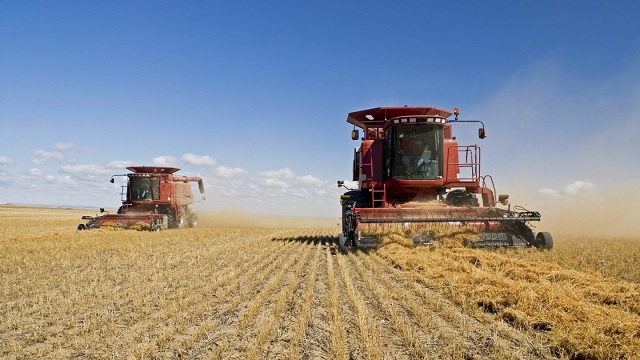Bruce Dowbiggin
Snuffed-Out Flames: From Beatdown To Teardown in 18 Months

“Sic transit gloria” There have been rude collapses in the NHL’s recent past, but few have happened with such alacrity as the Calgary Flames’ descent into hell. Two years ago this April, the Flames were favourites to beat their provincial rivals, the Edmonton Oilers, in the second round of the 2022 playoffs. The Flames had beaten the Dallas Stars with a Game 7 OT snipe from Johnny Gaudreau. Meanwhile, the Oilers had been life-and-death to subdue the L.A. Kings in their own seven-game ordeal.
For two franchises looking to make a statement, this first playoff meeting of the Alberta rivals since 1991 was perfect timing. Led by the incomparable Connor McDavid and Leon Draisaitl, the Oilers had been knocking on the door to a long playoff run for a few years. The high-scoring Flames, meanwhile, had shocked the NHL by taking the Pacific after just one playoff series win since 2004. All three players on their top line— Johnny Gaudreau, Matthew Tkachuck, Elias Lindholm—had scored 40 or more goals, while goalie Jacob Markstrom was a Vezina Trophy nominee.
Yes, there were clouds on the Flames’ horizon. Gaudreau was weeks from being an UFA. His cohort Matthew Tkachuck, was likely to be asking for a boatload of money in contract talks. Numerous key veterans would also be up for pay raises within the next two years. But a win over their Edmonton rivals could dampen that downer.
Edmonton had no such contractual distractions, having sewn up their core of McDavid, Draisaitl, Ryan Nugent-Hopkins and Darnell Nurse. It showed. The series was over quicker than anyone expected. Even Game 1’s 9-6 decision for the favoured Flames saw them blow a 5-1 lead before salvaging the game. They also led Gm. 2 by 2-0 before Edmonton mounted another (successful) comeback. In fact, Calgary’s defence would not hold leads in the remaining four games of Edmonton’s 4-1 series triumph.
As the series dragged on, Calgary’s top line seemingly could not match the speed of McDavid and the Oilers’ deadly attack. Outside his series-opening hat trick, Tkachuk had just a single assist and a -4 rating in the series. Gaudreau had just two points in the final four games while Lindholm was held to a single goal and one assist in Games 2-5. (McDavid, by contrast, ended up with three goals and nine assists against suddenly porous Flames goalie Jacob Markstrom).

For those looking for the moment this Flames’ iteration fell apart, the blown leads in Games 1 & 2 is a good place to start. Coach Darryl Sutter did not gild the lily for his underperforming stars. “It’s not being critical, that’s just true. They’re going to tell you that, too. Missed opportunities go the other way.” For much of the next 18 months, the team would go into free-fall.
In the weeks after elimination, Gaudreau walked away from a max contract offer to sign in… Columbus? That led to Tkachuk forcing the ill-fated Jonathan Huberdeau trade from Florida after refusing to renegotiate a new deal in Calgary. Having signed an eight-year contract Huberdeau then collapsed to just 15 goals and 55 points. His staggering 60-point drop-off represented one of the worst in NHL history among non-injured players between two seasons. At one point Sutter even put enforcer Milan Lucic on Huberdeau’s line.
A dazed Huberdeau fumed. He had company as seemingly the entire team feuded with Sutter. As the Flames dropped to fifth in the Pacific (and out of the postseason) the noises began about which veterans wanted out if Sutter was retained. Sutter was finally dumped, but the damage had been done for new GM Craig Conroy in his first GM job. Unless his team started fast in 2023-24 he’d be conducting a rummage sale.
The Flames did not improve off their dreadful collapse in 2023-24. (Not helped by news that forward Dylan Dubé was arrested in the Team Canada 2018 sexual-assault scandal.) Yes, some youngsters like Conor Zary, denied a shot by Sutter, have shown well. But 14-16-5 in late December wasn’t enough. Having shipped Tyler Toffoli to New Jersey earlier (stealing Ygor Sherangovich) Conroy had to find suitable deals for his departing veterans when everyone in hockey knew he had no leverage. In short order, Chris Tanev, Nikita Zadorov, Elias Lindholm, Chris Tanev and Noah Hanafin were peddled for Andrei Kuzmenko, prospects Hunter Brzustewicz, Joni Jurmo, Artem Grushnikov, and Daniel Miromanov. The deals also bagged two more first-rounders, another second, four thirds, a fourth and a fifth pick— all spread over the 2024/25/26 drafts.

In a surprise move, Conroy hung onto ace goalie Markstrom to go with remaining veteran forwards Huberdeau, Nazem Kadri, Mikael Backlund, Blake Coleman and defensemen McKenzie Weager and Rasmus Andersson. Maybe Conroy deals him at the Draft? Depending on your outlook, the team is now gamely trying to a) sneak into a playoff spot or b) hurt its draft position by playing spirited, if undermanned, hockey.
There is much potential in the draft haul Conroy has engineered (he has two first rounders and two second rounders this June), less so in the actual bodies he obtained. A safe estimate might be that the Flames will not return to the postseason till their long-delayed arena is finally completed by 2027-28. Maybe a phenom will appear— a la Gaudreau—to speed things up.
But it’s a reach to say that Flames fan watching puck drop of the Edmonton series in April of 2022 could have foreseen this teardown happening so fast and so brutally to a team that sped out to a 5-1 lead over the Oilers that night. But it did. The only thing making it worse will be an Oilers Stanley Cup win in 2024.
Bruce Dowbiggin @dowbboy is the editor of Not The Public Broadcaster A two-time winner of the Gemini Award as Canada’s top television sports broadcaster, he’s a regular contributor to Sirius XM Canada Talks Ch. 167. Inexact Science: The Six Most Compelling Draft Years In NHL History, his new book with his son Evan, was voted the seventh-best professional hockey book of all time by bookauthority.org . His 2004 book Money Players was voted sixth best on the same list, and is available via brucedowbigginbooks.ca.
Bruce Dowbiggin
Why Do The Same Few Always Get The Best Sports Scoops?

The Toronto Maple Leafs made the “what colour is that green light?” decision to fire their head coach Sheldon Keefe last week. The removal of Keefe after five years followed a dispiriting first-round playoff series loss to a very ordinary Boston Bruins team. Coaching may or may not have been the root cause of that loss. (Keefe himself admitted “teams are waiting for the Leafs to beat themselves”.)
The real reason for the firing is 1967, and we don’t think we need add more than that.
In essence, the management of MLSE— the owner of the Maple Leafs and a lot of other sports stuff in Toronto— needed to throw a body to the baying hounds of disappointment. Also known as Leafs Nation. Newly minted CEO Keith Pelley, fresh from the PGA Tour/ LIV psychodrama, was certainly not going to pay the price.
Nor was GM Brad Treliving who has only been on the job for two seasons. The key decisions on Toronto’s lopsided salary cap were decided long before Treliving occupied his desk. That left two people in vulnerable positions. 1) Maple Leafs president Brendan Shanahan, who has been drawing an MLSE cheque for a decade. 2) Keefe.
When was the last time you saw a coach fire a team president? Precisely. Keefe joins the list of (briefly) unemployed coaches who circulate in the NHL like McKinsey consultants. Shanahan gets a lukewarm mulligan from Pelley. But after the failure of the Kyle Dubas experiment— “who needs experience?”— and now just a single playoff series win in a decade Shanny’s best-before date has arrived.

Toronto Maple Leafs president Brendan Shanahan attends a news conference in Toronto on April 14, 2014. Toronto Maple Leafs president Brendan Shanahan said Peter Horachek will remain the team’s interim head coach until the end of the season. Shanahan met the media Friday for the first time since coach Randy Carlyle was fired on Tuesday. THE CANADIAN PRESS/Chris Young
Depending on who he and Treliving enlist to coach— remember, Mike Babcock was too tough and Keefe was probably too player friendly— it had better produce instant results. Because Shanny, the pride of Mimico, is out of chances. The coach choice will also be affected by whichever player or players that management decides are superfluous to ending the Leafs’ ridiculous run of misery.
The Leafs brass’ press conference last Thursday did little to shed light on what happens after Keefe’s expulsion. Just a lot of MBA determinism on a bed of baffle gab. A crabby Steve Simmons question/rant briefly threatened the harmony of the moment, but order was restored. And the media bitching switched from the press box to social media and podcasts.
Speaking of the fourth estate, the other unmentioned aspect of this story— indeed every story in the NHL these days— is just how it was revealed to the public. When people sipped their morning Tim’s or Starbucks the (almost) coincident bulletins came down the social media pike about Keefe’s dismissal.
Predictably, Chris Johnston of Sportsnet and Daren Dreger of TSN announced the breaking news within heart beats of each other. While there had been speculation on Keefe’s fate for days, the announcement coming from the networks duo confirmed the story in the minds of the industry. That allowed everyone else drawing a cheque as a hockey journalist to pile in and swarm the dead body.
In today’s sports journalism, where social media has replaced newspapers, scoops are governed by a protocol. There are the heralds— in the NHL it’s currently Johnston and Dreger— and then there are the disseminators. The days of a rabble of reporters all scrambling to get a story bigger than who-will-play-in-tonight’s-game are gone. Today, it’s a very narrow funnel for scoops.
It’s the same in the NFL where Ian Rappaport (NFL Network) and Adam Schefter (ESPN) monopolize the tasty scoops on behalf of their employers, who also happen to be NFL rights holders. In the NBA, Brian Windhorst (ESPN) has the inside rail when it comes to the LeBron James/ Steph Curry scoops. In MLB… it’s probably Ken Rosenthal (The Athletic) but no one cares about baseball anymore, do they?
The leagues like it this way, doling out stories to guys they can trust. None of this is criticism of Johnston or Dreger, who have deftly maneuvered themselves into the coveted “from their lips to your ears” spots. From our own experience we can remember the exhilaration of having the best source or sources on the really big stories. Like Johnston/ Dreger, we worked hard for a long time to develop those sources and only very reluctantly let anyone else horn in on our stories.
It was also our observation that this order of things journalistic suited a lot of reporters who either couldn’t get good sources or didn’t want the stress of being first on stuff. It was enough that, like the Keefe story, they’d get the goods eventually and most fans would not care who was first. So long as you had a take. So be it.
Some resentful types took potshots at our work if it upset their pals in the dressing room or the management suite. On the Stephen Ames/ Tiger Woods story in 2001, we had the late Pat Marsden tell us on air that we’d done a great job on Ames’ criticisms of Tiger. Only to hear him lambaste us— again on FAN 590— only minutes later as we listened driving home from the studio. But we digress.
Many reporters are complacent in playing the game, so long as their bosses didn’t enquire why they are getting scooped all the time by the same few rivals. With the death of daily newspapers that doesn’t happen much any longer. (Many editors today may only see stories when publication brings a libel notice.) For them a salty take is good enough.
The scoop business is also affected by the multiple roles now demanded of sports media types. In addition to their “day job” on a beat they also have to supply digital content and talk-back hits to the Mother Ship. Most also are feeding a weekly podcast, dictating time on air rather than time working the phone. There are only so many hours in a day to chase a story.
Better to play the Breaking News waiting game.
Bruce Dowbiggin @dowbboy is the publisher of Not The Public Broadcaster A two-time winner of the Gemini Award as Canada’s top television sports broadcaster, he’s a regular contributor to Sirius XM Canada Talks Ch. 167. Now for pre-order, new from the team of Evan & Bruce Dowbiggin . Deal With It: The Trades That Stunned The NHL & Changed Hockey. From Espo to Boston in 1967 to Gretz in L.A. in 1988 to Patrick Roy leaving Montreal in 1995, the stories behind the story. Launching in paperback and Kindle on #Amazon this week. Destined to be a hockey best seller. https://www.amazon.ca/Deal-Trades-Stunned-Changed-Hockey-ebook/dp/B0D236NB35/
Bruce Dowbiggin
Getting Real About Justin’s Real Estate Economy. It Won’t Last

Have you ever been to a concert where a hot new product like Tesla is mentioned and many in the crowd applaud in approval? Have you been at a dinner party when you say you went to a new Thai restaurant, and everyone at the table explodes in rhapsodic glee? Have you ever been to see a comic and he mentions he has the latest iPhone with the nifty camera and people actually cheer?
You see those people cheering a piece of tech or a style of cuisine? Those are the people who believed Justin Trudeau when he told them to sink everything into real estate when interest rates were near zero. They. Will. Believe. Anything. So long as they think it makes them cool kids. Trudeau could say he can control the weather by stopping cows from farting, and they’ll be wearing a bovine flatulence T-shirts pronto.

Now, we can hear you laughing in derision at our skepticism about the real estate-economy that has taken over the nation— the new economy that Justin fed, watered and then bragged about. (To the exclusion of the other cornerstones of our once-dynamic nation state.) The one that will be going to Market one of these days for a meeting with an air compressor.
Again, you laugh. Despite the housing shortage Justin says we can easily accommodate two million new souls a year, no problem. He says Trump was a vile racist for wanting to exclude unhinged radicals from zombie countries back in 2017. The freshly-arrived from Trump’s “shithole countries” with “shithole value systems” and “shithole economies’ will prop up the value of Canada’s two-million dollar cash-cow bungalow in West Van or Etobicoke. And the Happy People believe.
Why? Because Justin and his cabinet are in Control, and they’ll just rein in these types when they get here and start asking that Jews be exterminated or white people surrender the merit system to DEI droogs. That little dustup at the universities where nervous trust-fund virgins claim to be onside with systemic rape? Justin can stop them anytime. Everything is cool. After all, Canada is the model for a postmodern state.
And that stuff about how the Canadian real estate market being 80 percent propped up by drug money, kleptocracy profits and Blackrock? Pshaw. That is just the Far Right Diagolons trying to panic you into hiding your money from the government which just wants to send it to the “shithole” countries in a kickback loop. If nothing else, the banks will save you— if there’s any shareholder value left after this deranged DEI diversion.
Can’t happen here? We know people who were around the EU in 2008 when the U.S. mortgage debacle cratered economies around the world. For years they’d been served by Poles in the service industry, Spaniards in the restaurant kitchens and Bulgarians doing the physical labour. Life was good. Everyone drove a Beemer and owned a condo overlooking the sea.
Then, one day, they noticed that all the airport parking lots were overflowing with Beemers that went unclaimed. No one had paid rent in months. The banks noticed that all these lovely fellow citizens of the EU had drained their savings, reached their cash credit limit on the Mastercard and skedaddled with the dough. Funny, they all must have gone on holidays to once, no?

No. They were gone. Bye bye. Adios. And the credit bubbles in Ireland, Norway, Iceland, France and other EU worthies popped like the champagne they’d been sipping for years on easy credit and idiotic notions of productivity. Nations like Iceland went bankrupt overnight. Counties in England threw their keys on the table. People’s life savings evaporated.
But Justin says that won’t happen here on his co-watch with Jagmeet the Bespoke. Sure, no one under the age of 40 can afford those two-million dollar cash-cow bungalows in West Van or Etobicoke. But those old Boomer geezers will die soon, and after we tax the daylights out of the estate, the kiddos will inherit the house. Probably after we turn it into a four-plex or fine them for having empty bedrooms because they couldn’t afford kids.
One of the ferocious beauties of market economies is their way of periodically turning on themselves when too many people are getting rich too easily. The Canadian RE economy of Justin Trudeau is one of them. It’s about a decade old without any sign of dropping. Life is good. Everyone drives a Tesla and rents a condo overlooking the sea.
Little wonder. Everything he and his faculty lounge of dimwits like Chrystia Freeland, Melanie Joly and Steven Guilbeault have done this decade has been to prop up the value of real estate owned by their real pals in Asia, Europe, the assorted kleptocracies in Africa or the sub-continent. It was like an ad for Chlorox the way these “investors” blithely laundered their dirty money in Canadian condos and low-rises. When news leaked out that mobsters were using casinos in B.C. (where Justin’s maternal side came from) as a laundering station it was covered up very quickly.
But the clock ticks. Even Justin’s former finance minister Bill Morneau is warning that the bubble is going to pop if Justin keeps printing more money to keep the real estate values so unsupportably high. The entire middle class of Canada, which has ridden the real estate train, will see their life savings evaporate like Jody Wilson Raybould’s political career.

No matter. Justin’s been living in government housing since 2015 (some of it with his Mommy). What does a trust-fund nit know about making rent cheques or a mortgage payment? Without Sophie spending like a dervish, he never needs to look at an America Express card again. He’s got 17 more months to build up credits with his future benefactors, and he’s not applying the handbrake now.
Okay, you can applaud now.
Bruce Dowbiggin @dowbboy is the editor of Not The Public Broadcaster A two-time winner of the Gemini Award as Canada’s top television sports broadcaster, he’s a regular contributor to Sirius XM Canada Talks Ch. 167. Now for pre-order, new from the team of Evan & Bruce Dowbiggin . Deal With It: The Trades That Stunned The NHL & Changed Hockey. From Espo to Boston in 1967 to Gretz in L.A. in 1988 to Patrick Roy leaving Montreal in 1995, the stories behind the story. Launching in paperback and Kindle on #Amazon this week. Destined to be a hockey best seller. https://www.amazon.ca/Deal-Trades-Stunned-Changed-Hockey-ebook/dp/B0D236NB35/
-

 conflict18 hours ago
conflict18 hours ago‘It Makes No Sense’: Experts Puzzled By Biden Admin’s Claim That Rafah Invasion Wouldn’t Help Israel Defeat Hamas
-

 Opinion9 hours ago
Opinion9 hours agoCanada’s fertility, marriage rates plummet to record lows: report
-

 Brownstone Institute1 day ago
Brownstone Institute1 day agoMedical Elites’ Disgrace Over Ivermectin
-

 COVID-1912 hours ago
COVID-1912 hours agoFormer COVID coordinator Deborah Birx now admits jabs could have injured ‘thousands’
-

 Bruce Dowbiggin16 hours ago
Bruce Dowbiggin16 hours agoWhy Do The Same Few Always Get The Best Sports Scoops?
-

 Energy15 hours ago
Energy15 hours agoBuckle Up for Summer Blackouts: Wind Is Already Failing Texas in Spring
-

 Bruce Dowbiggin2 days ago
Bruce Dowbiggin2 days agoGetting Real About Justin’s Real Estate Economy. It Won’t Last
-

 COVID-1918 hours ago
COVID-1918 hours agoThe New York Times Admits Injuries from COVID-19 Shots








